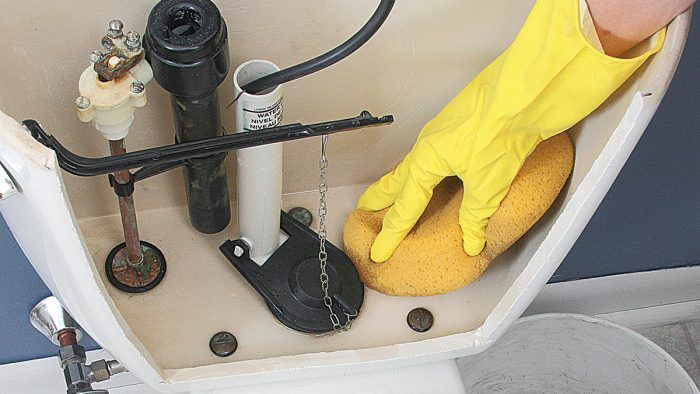
In most cases it will take only a few minutes to diagnose a toilet problem. Most repairs take less than half an hour. Following the instructions in the pages that follow, you may spend more time going to the hardware store or home center for the parts you need than you will on the actual repair. Here are the most common ailments and their cures:
- Toilet is clogged and overflows or will not flush with force: Clear the clog with a toilet auger, plunger, or pressure-assisted drain opener.
- Water leaks from the bowl onto the floor: Deal with this problem immediately, because it could damage your flooring and even your home’s structure. Shut off the water, remove the toilet, and replace the wax ring.
- “Phantom flushes”: If your toilet makes soft flushes on its own from time to time, water is leaking out of the tank and into the bowl. To verify that this is happening, pour a few drops of food coloring into the tank, wait a half hour or so, and see if the color has seeped into the bowl’s water. To repair, clean the valve seat and adjust or replace the stopper or flapper, so water cannot leak out of the tank.
- Water constantly runs (often with a hissing sound): Most likely, the tank water is all the way up to the top of the overflow tube and running into it. Adjust the float cup, valve, or tank ball to bring the water level down at least 1⁄2 in. below the top of the overflow tube. If that doesn’t solve the problem, install a new float cup assembly or other type of valve.
- You sometimes need to jiggle the handle to stop the sound of running water: This happens if you have an old ballcock valve with a lift wire and stopper. You can try to bend the wire to get it to slide more smoothly, but a better solution is to replace it with a flapper and lift chain—and perhaps a new float cup valve while you’re at it.
- A leak that comes from the tank: If the leak is at the water inlet, tighten the water-supply nut or replace the supply tube. If the leak is elsewhere, tighten the tank bolts (there may be two or three). On an old toilet, you may need to replace the rubber washers. If the tank is cracked, replace it (if you can find an exact replacement) or replace the entire toilet.
- Weak flushes: If the water level in the tank is lower than 1⁄2 in. below the top of the overflow tube, adjust the float cup or ball or the valve to bring the level up. If the flapper or stopper sinks down onto the flush valve seat too soon, replace it. If the toilet has always produced inadequate flushes, it may be an early-model low-flush toilet; replace it with a newer model.
- Turning the handle does not produce a flush: See that the handle is connected to the flapper or stopper; if not, reattach. If there is no water in the tank, make sure the stop valve is turned on and squirting water; you may need to replace the stop valve or the supply tube.
|
|
Draining a tank and bowl
Though many of the repairs on the following pages can be done with water in the tank and the bowl, some require dry conditions, and you may feel more comfortable with at least the tank empty.
| TIP: If you will empty the bowl as well as the tank, flush the toilet, wait for it to refill, and flush again. This will ensure that the water in the bowl is at least fairly clean. |
|
|
|
Handles
Handles can come loose and simply require tightening. Or you may choose to replace yours. The handle is the only visible piece of metal on a toilet, and replacing one can provide a quick and inexpensive visual upgrade.



Replacing a Float BallIf a float ball is cracked, water will seep in and it will no longer float well. You can buy a replacement ball: Just unscrew the old one and screw on the new one. |
Adjusting water level
In most cases, your toilet will run best if the tank water fills up to about 1⁄2 in. or 1 in. below the top of the overflow tube. Adjusting the level is usually a simple matter.




Excerpted from Plumbing (The Taunton Press, 2016) by Steve Cory.







